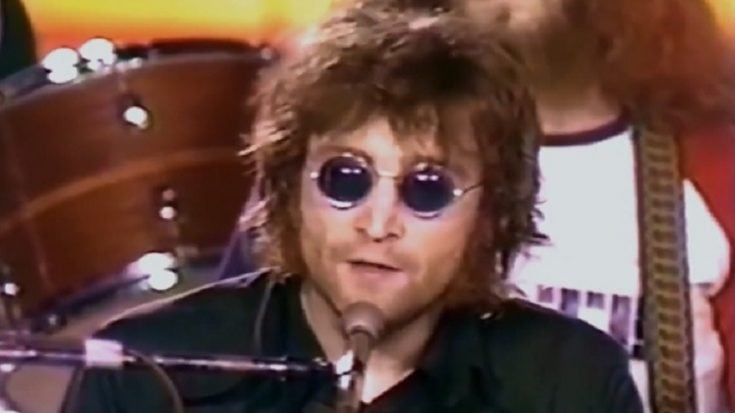The 10 Songs You Didn’t Know John Lennon Wrote

John Lennon Sings Imagine Live - Kurt Max? /YouTube
When you think of John Lennon, the first thing that comes to mind is likely his legendary role as one of the founding members of The Beatles. His contributions to the world of music with the Fab Four are nothing short of iconic, shaping the course of popular music history.
However, what many people may not realize is that Lennon’s songwriting prowess extended far beyond the boundaries of The Beatles.
In addition to penning some of the most beloved Beatles classics, John Lennon also lent his songwriting talents to other artists, crafting memorable tunes that have sometimes remained hidden in the shadow of his Beatles legacy.
Prepare to be surprised and delighted by the hidden treasures in Lennon’s songwriting catalog as we explore the uncharted territory of his musical genius beyond The Beatles.
10. “It’s for You” by Cilla Black (1964)
Whether you’re familiar with her singing career or recognize her as the host of Blind Date, it’s undeniable that Cilla Black enjoyed a remarkable career. She ventured into various aspects of the entertainment industry, even collaborating with two members of The Beatles, namely Paul McCartney and John Lennon.
While the song “Love of the Loved” is typically credited to Lennon and McCartney, it was in the creation of “It’s For You” that Lennon truly showcased his songwriting skills.
During Cilla’s recording session for her breakout hit “Anyone Who Had a Heart” at Abbey Road Studios, McCartney made an appearance and proposed that he and Lennon write a song for her, drawing inspiration from the singer’s popular track.
“It’s For You” swiftly ascended to the ranks of the UK Top Ten hits in 1964. In the United States, Black’s rendition of the song managed to reach a modest peak at No. 79 on the charts. Interestingly, a 1971 rendition by the Detroit-area group Springwell, recorded in Canada, surprisingly outperformed all other versions of the classic hit in North America.
9. “Fame” by David Bowie (1975)
In 1975, Lennon generously contributed his songwriting skills to David Bowie, whom he considered a friend. Their partnership on this particular track was driven by a shared discontent with the pressures and complexities that often accompany fame and fortune.
The outcome of their collaboration was nothing short of exceptional, with many considering this song as the ultimate favorite in Bowie’s eclectic catalog. Additionally, Lennon also contributed more to the track by providing his guitar work and lending his vocals in the background.
It remains a rueful lament that these two legendary musical figures, both now sadly departed, never had the opportunity to join forces once more in the world of music.
Across North America, “Fame” enjoyed resounding commercial success, marking a significant milestone in Bowie’s career. It soared to the top of both the US Billboard Hot 100 and the Canadian Singles Chart, ultimately clinching the number 7 spot on the Billboard Year-End Hot 100 chart.
8. “Bad to Me” by Billy J. Kramer with the Dakotas (1963)
The success of Billy J. Kramer and the Dakotas owes a significant debt to none other than Lennon and McCartney. Their collaboration particularly with Lennon extended to not just one but a minimum of five distinct songs that found their way into the group’s repertoire.
Among these, the most noteworthy is perhaps “Bad to Me”, a song that clinched the top spot on the UK charts in 1963.
Interestingly, the story behind “Bad to Me” has its own share of intrigue. It’s said that John initially claimed to have written the song for Billie while he was vacationing in Spain. However, this narrative later was changed when John asserted that he and Paul wrote the song during a van ride.
“Bad to Me” soared to the number 1 spot on the UK Singles Chart the same year it was released. The single made its way to the United States in the following year, ultimately reaching No. 9 on the charts.
7. “I’m in Love” by The Fourmost (1963)
In 2013, a demo version of this song recorded by The Beatles, was made public. However, for many years before that, it was recognized as one of the hits attributed to Merseybeat band The Fourmost.
It strongly indicates that John Lennon was the primary songwriter for this track, as he affirmed in a 1971 interview that he initially composed it with The Fourmost in mind. Yet, in a 1980 interview with Playboy magazine, he appeared less certain, remarking, “That sounds like me, I don’t remember a hell of a thing about it”.
It’s worth noting that Lennon and McCartney also crafted “Hello Little Girl” for The Fourmost, but this fact is more widely known.
“I’m in Love” was recorded by many artists, and even The Beatles’ version of the song was covered by many other groups. One such cover was found on the 1989 album titled Secret Songs: Lennon & McCartney by Bas Muys, and the other is on the 1998 album It’s Four You by the Australian tribute band The Beatnix.
6. “That Means a Lot” by P.J. Proby (1965)
Many Beatles enthusiasts will undoubtedly recognize the 1965 film Help! featuring the Fab Four, where they encounter a series of zany adventures, from contending with sinister cults to dealing with eccentric scientists.
Surprisingly, the song “That Means A Lot” was originally intended for inclusion in that very movie, and it emerged from the creative minds of Lennon and McCartney. However, in their own words, they were dissatisfied with the outcome, feeling that the song didn’t quite suit their vocal abilities.
Consequently, they decided to relinquish the song, and it eventually found its way into the repertoire of an American singer. The band’s manager Brian Epstein entrusted “That Means a Lot” to the American singer, who was one of the talents under his management.
In later years, John appeared to revise his perspective, asserting that the song was primarily the brainchild of Paul. Nonetheless, to any discerning fan, it remains evident that John’s creative influence permeates the composition.
5. “God Save Oz” by Bill Elliot (1971)
If this song isn’t on your radar, there’s no need for forgiveness; it’s not widely recognized, particularly in the UK or the US. Perhaps part of the reason for its relative obscurity lies in the fact that Lennon’s involvement wasn’t widely known.
At a pivotal juncture when the magazine Oz was embroiled in obscenity charges stemming from their controversial “school kids issue”, many people protested against the legal actions. In a show of solidarity with the magazine, Lennon, and purportedly Yoko Ono, wrote “God Save Oz”.
However, Lennon didn’t intend for it to follow as a successor to the highly successful “Power to the People”. Due to contractual obligations, Lennon found the need to have another vocalist replace his own part in the song. Bill Elliott’s vocals were later overdubbed onto the master recording, and this process also included the addition of vocal parts by Yoko Ono.
Lennon’s initial recording of “God Save Oz took place at Ascot Sound Studios, a recording studio near his home at Tittenhurst Park in Berkshire. On April 13, 1971, the demo was created in a single uninterrupted take, featuring Lennon on acoustic guitar and vocals, accompanied by Steve Brendell on congas.
4. “Mucho Mungo” by Harry Nilsson (1974)
This track by Harry Nilsson, also known as a medley with his own composition “Mount Elga”, captured considerable attention in 1974. Interestingly, the song’s creation involved the collaborative efforts of John Lennon and Phil Spector, the renowned musician who later became infamous for his criminal actions.
As the story goes, when John Lennon presented the song to Nilsson, the singer-songwriter pointed out the specific sections he found less appealing, all of which had been penned by Phil Spector.
Consequently, what remained was a remarkably memorable song, and it wasn’t until many years later that fans had the opportunity to listen to the original demo version recorded by Lennon himself.
The Beatle himself created three home demos of the song, with the notable inspiration of guitarist Jesse Ed Davis in mind. However, the song found its way into the recording sessions for Nilsson’s album Pussy Cats, a project overseen by Lennon in 1974.
3. “Move Over Ms. L” by Keith Moon (1975)
An often overlooked gem in Lennon’s songwriting repertoire, this particular track might ring a bell for some fans as having been interpreted by Keith Moon, the drummer of The Who.
What adds an intriguing twist to this release is that not long after Lennon had shared the song with Moon, he decided to unveil his own rendition, coincidentally in the same year. It was included as a B-side for his cover of “Stand by Me”.
The consensus among many music enthusiasts and historians is that Lennon’s version outshines Moon’s interpretation, prompting some to speculate whether the version passed on to Moon might have been incomplete at the time of its handover.
The drummer included his rendition of “Move Over Ms. L” on his 1975 album Two Sides of the Moon, and subsequently, it appeared as the B-side of his “Solid Gold” single. Moon’s rendition maintained a musical arrangement quite similar to Lennon’s, albeit featuring distinct horn riffs.
2. “I Wanna Be Your Man” by the Rolling Stones (1963)
The age-old debate about who reigns supreme between The Beatles and The Rolling Stones has sparked fervent discussions over the years. Surprisingly, the relationship between these two legendary bands was far from chaotic.
In fact, during their early years, John and Paul collaborated to compose a song that would eventually find its way into the Rolling Stones’ repertoire.
Although McCartney often receives primary songwriter credit, the narrative suggests that it was Lennon who put the finishing touches on the track. Mick Jagger has openly shared his delight with the song, and quite frankly, who could blame him?
Dropped as their second single on November 1, 1963, the Stones’ rendition became their first entry into the UK’s Top 20 chart, securing the 12th spot. This rendition showcases the unmistakable slide guitar work of Brian Jones. “I Wanna Be Your Man” is one of the rare Rolling Stones tracks with Jones exclusively handling backing vocals.
1. I’m the Greatest” by Ringo Starr (1973)
It’s hardly surprising that Lennon extended a helping hand to his former Beatles bandmate, Ringo Starr, in the aftermath of the group’s dissolution. As one might have guessed, the title of the track was inspired by Muhammad Ali’s famous quote.
John made the deliberate decision not to personally deliver the line, “I’m the greatest”, as he felt it might come across as conceited. However, he had full confidence that Ringo could carry it off without raising eyebrows.
What adds an intriguing layer to the story is that George Harrison also made a contribution to the song, marking the only instance of these three former bandmates collaborating after the Beatles’ breakup.
Some analysts regard “I’m the Greatest” as one of the standout tracks in Ringo Starr’s solo repertoire. In a contemporaneous critique for Rolling Stone, Ben Gerson lauded it as a song where “a stunning alchemy occurs”.





















